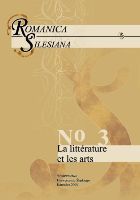Poesía visual de José Juan Tablada
The visual poetry of José Juan Tablada
Author(s): Marta Kobiela-KwaśniewskaSubject(s): Language and Literature Studies
Published by: Wydawnictwo Uniwersytetu Śląskiego
Keywords: Visual poetry; ideographic poems; haiku; José Juan Tablada; Mexican poetry
Summary/Abstract: The present article focuses on the visual poetry of the Mexican poet José Juan Tablada who is one of the most important precursors of the avant-garde in the twentieth century. As numerous critics have remarked, José Juan Tablada made several major contributions to modern poetry in Mexico. Although Tablada is generally credited with having introduced Latin American poets to the Japanese haiku, he was also responsible for encouraging them to experiment with visual poetry. As a result of a visit to Japan in 1900, José Juan Tablada became interested in haiku tradition and in Japanese ideograms which inspirited him to create his own poetry in the style of oriental work but adopted to the Latin American perspective of his imagination and to the rules of the Spanish language. It appears that Tablada´s attention was focused mainly on the experiments of the modern French Imagist poets and was influenced by Apollinaire´s "Calligrammes", a problem that we partially intend to explain in the present article spotlighting some occurrences, but finally we conclude that both poets must have been inspired by the previous form of visual poetry, known to the ancient Greeks as technopaigneia and to the Romans as carmina figurata, or by the pre-Hispanic ideogra phic forms; in this subject we consider a long list of possible inspirations. The principal idea of this paper is to analyse the visual poetry of Tablada from the perspective of its interdisciplinary character, where images and words situate his poems in a spatial configuration. Therefore we have concentrated our attention on two books of poems published in Caracas, the first one entitled "Un día… Poemas sintéticos" edited in 1919, and the second one, "Li-Po y otros poemas", published in 1920, as an example of the so called visual poetry or ideographic poems, a denomination more appropriate for the second collection. To sum up, Tablada was an innovator, though he did borrow ideas like most writers do. His haikus are original, accompanied with his self-made drawings, and have a distinct Mexican flavor containing local references to flora, fauna o Mexican culture — characteristics that we underline in this paper while also providing a general overview of some theoretical aspects related to Literature and Art.
Journal: Romanica Silesiana
- Issue Year: 2008
- Issue No: 3
- Page Range: 82-94
- Page Count: 13
- Language: Spanish

